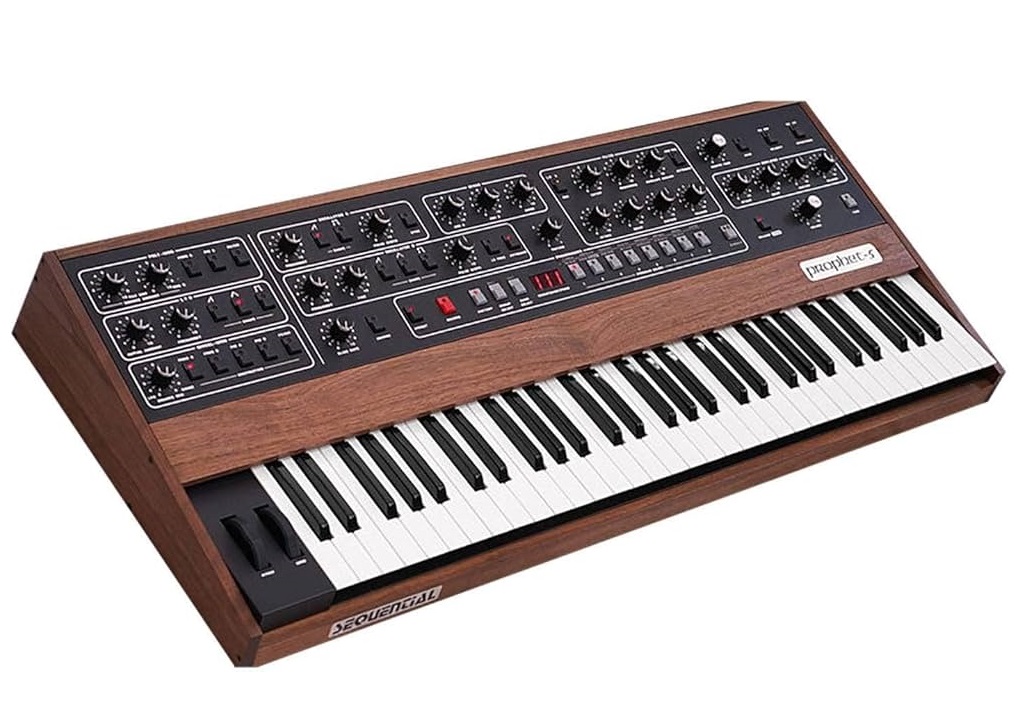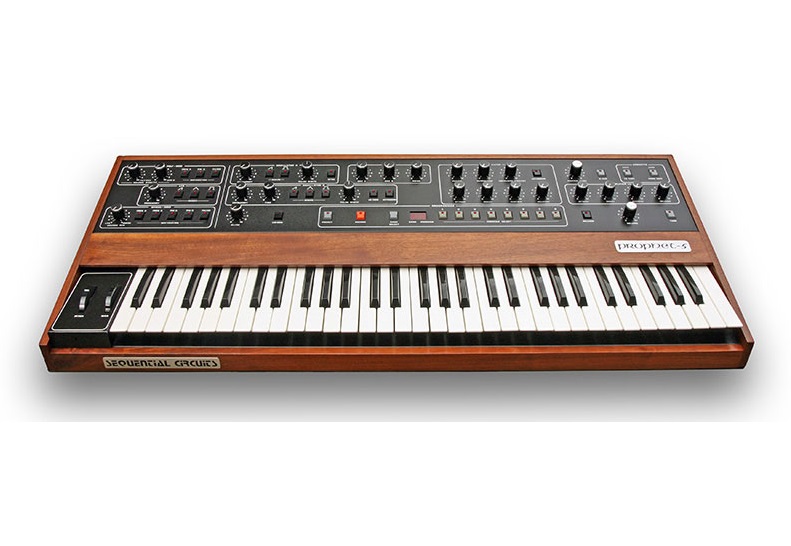Sequential Circuits Prophet-5
Electronic Instruments
America
Between 1901 and present
Video
The Sequential Circuits Prophet-5 is an iconic analog synthesizer that revolutionized the world of electronic music. First introduced in 1978, it was one of the first fully programmable polyphonic synthesizers, allowing musicians to store and recall sounds with the use of microprocessors. The Prophet-5 features five voices of polyphony, each voice consisting of two voltage-controlled oscillators (VCOs), a resonant low-pass filter, an amplifier, and two envelope generators.
The synthesizer is well-known for its warm, rich, and expressive sound, making it a favorite among musicians and producers across various genres. It became an essential tool in synthesizer music, defining the sound of the late 1970s and 1980s. Over the years, different models of the Prophet-5 have been released, including the Rev1, Rev2, and Rev3, each with unique internal circuit modifications that slightly alter the sound and performance capabilities.
History and Origin
The Prophet-5 was developed by Dave Smith, the founder of Sequential Circuits, in the late 1970s. Before its introduction, most synthesizers were either monophonic or required manual patching to recall sounds. Smith aimed to create an instrument that could offer polyphony along with patch memory, making it easier for musicians to use in live and studio settings.
The Prophet-5 was first introduced in 1978 at the NAMM Show, quickly gaining popularity among professional musicians and producers. The first version, Rev1, was built in limited numbers and had some reliability issues. Rev2 followed shortly after, featuring improvements in stability and durability. The most widespread version, Rev3, introduced Curtis CEM chips, which slightly altered the sound but made the synthesizer more affordable and reliable. During the 1980s, the Prophet-5 was used by legendary artists such as Peter Gabriel, Phil Collins, Madonna, Michael Jackson, Vangelis, and Depeche Mode, among many others. It became a staple in pop, rock, and electronic music, influencing an entire generation of sound designers and composers.
Unfortunately, due to financial difficulties, Sequential Circuits ceased operations in 1987, and Dave Smith moved on to work with Yamaha and later founded Dave Smith Instruments. However, the Prophet-5 remained a beloved classic, leading to a resurgence in interest, and was officially reissued by Sequential (a revived company) in 2020, with modern updates while maintaining the original’s sonic characteristics.
Types and Features of the Prophet-5
Variants of the Prophet-5
There were multiple revisions of the Prophet-5, each with slight modifications:
- Rev1 (1978) – The original model, produced in very small numbers, had a distinct warm and unstable character.
- Rev2 (1978–1979) – Introduced improvements in stability and minor hardware revisions.
- Rev3 (1980–1984) – The most popular version, utilizing Curtis CEM chips for cost efficiency and reliability.
- Prophet-10 – A dual Prophet-5, offering ten voices but facing some overheating issues.
- Prophet-5 (2020 Reissue) – A faithful recreation of the original with modern improvements such as MIDI and USB connectivity.
Notable Features
The Prophet-5 features two oscillators per voice, capable of generating sawtooth, triangle, and pulse waveforms. The low-pass filter provides smooth resonance and warmth, defining the Prophet’s signature tone. Two ADSR envelopes control the amplifier and filter, providing dynamic shaping capabilities. The synthesizer includes an LFO and modulation routings for expressive sound design. A revolutionary feature at its time, allowing users to save and recall patches. Includes USB/MIDI, velocity sensitivity, and aftertouch while preserving the original sound.
The Prophet-5 in Music
The Prophet-5 became an industry standard in music production, widely used in various genres, including pop, rock, electronic, new wave, and film scoring. Its lush pads, punchy basses, and ethereal leads made it a preferred choice for numerous artists.
Genres and Artists
Pop and Rock – Artists such as Michael Jackson (notably on Thriller), Fleetwood Mac, and Madonna used the Prophet-5 to create lush synthesizer textures.
Electronic and New Wave – Bands like Depeche Mode, Gary Numan, and Duran Duran heavily relied on the Prophet-5 for their signature sound.
Film Scoring – Renowned composers like Vangelis (Blade Runner soundtrack) and John Carpenter (Halloween theme) incorporated the Prophet-5 for cinematic effects.
Significance of the Prophet-5
The Prophet-5 was not just another synthesizer; it represented a paradigm shift in electronic music production. It paved the way for modern synthesizers by introducing preset memory, allowing for efficient workflow in both live and studio settings. Its impact can be seen in both hardware and software synthesizers, inspiring countless virtual instrument emulations and modern analog reissues.
Influence on Modern Synths
Many contemporary synthesizers, such as the Dave Smith Instruments Prophet-6, Sequential Prophet X, and Arturia’s Prophet V software, are directly inspired by the Prophet-5. The resurgence of analog synthesizers in the modern era owes much to the legacy of the Prophet-5.
Enduring Popularity
Even with advances in digital technology, the Prophet-5 remains highly sought after by producers and musicians who appreciate its warm, organic, and timeless sound. Its reissue in 2020 reaffirmed its place as one of the most legendary synthesizers ever made.
FAQ
What materials are used in constructing a Sequential Circuits' keyboard casing?
Sequential Circuits initially used koa wood casings but later switched to walnut wood during mass production phases like Revision 2. For modern versions like Rev4 models released after rebranding under Dave Smith Instruments now known as Sequential LLC again might differ slightly. Materials may vary based on specific revisions. Wood remains prominent historically.
How does construction differ between early hand-assembled units versus mass-produced ones?
Early units were hand-assembled primarily during Revision 1 production phases.Mass-produced models saw significant improvements including better durability. Later revisions incorporated new technologies such as cassette storage systems. These advancements enhanced overall reliability compared to initial handmade versions.
What electronic components were crucial during different stages of construction?
Initially SSM chips were used but later replaced by CEM chips starting from Revision Three onwards due mainly because they offered improved stability over their predecessors while maintaining similar functionality levels required within these types devices at that period time frame when those particular parts became available commercially speaking generally speaking about electronic component evolution trends observed throughout history up until today still being utilized albeit perhaps less frequently.
 Links
Links
References
Other Instrument
Categories



















